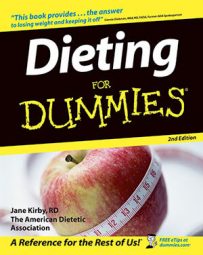Fruits and vegetables provide vitamins, minerals, and fiber necessary for proper nutrition. They’re also naturally low in fat with few exceptions. Breakfast is a good place to begin adding fruit servings to your diet.
You may already start your day with a glass of juice. Add a midmorning snack of fruit and have some for dessert at lunch or dinner, and you’ve made your goal of three to four servings a day.
Make at least one serving each day a citrus fruit. Orange and grapefruit juice are standard options, but don’t forget about the many varieties of oranges (navel, temple, Valencia, blood, and mandarin) and grapefruits (Ruby Red, white, and pink) that are available, as well as tangerines, tangelos, kumquats, and Ugli fruit, which are also considered citrus fruits.
When possible, select fresh fruit in season. In the Northern Hemisphere, you can buy fresh strawberries in February and apples in May. But because they aren’t in season, the fruit must be flown into the market from other climates or put into storage. Out-of-season fruit tends to be grown for longevity rather than flavor. Choose oranges and grapefruit in winter and berries in spring, to improve your chances of getting locally grown fruit.
Many critics of the pyramid believe the recommended servings of fruits and vegetables are too low. The Nurse’s Health Study of more than 80,000 people demonstrated that people who ate more than eight servings a day had a 20 percent lower risk of heart disease than those who ate three or fewer servings.
Further, their research showed that for each serving of fruits or vegetables, risk of heart disease decreased by 4 percent. Green leafy vegetables and vitamin C rich fruits had the greatest effect.
Experiment with new fruits that you haven’t tried before — figs, guava, star fruit, or prickly pears, for example. Many supermarkets stock large varieties of fruits worth investigating. Or you may want to use a meal out for a taste test, which can also give you an idea of an appropriate and skilled way to prepare the new fruits.
Try less-common varieties of favorite fruits, such as Winesap or Rome apples; Casaba, Persian, or Santa Claus melons; or Comice or Seckel pears. Blend fresh or frozen fruits together with a dollop of lowfat yogurt, a splash of orange juice, and a ripe banana for a scrumptious fruit smoothie.
Toss citrus segments, grape halves, or strawberries in with mixed greens and add lowfat poppy-seed dressing for a pretty and nutritious salad. Or sprinkle fresh or dried fruits on cereal, on frozen or regular yogurt, into muffin batter, or into rice and stuffing dishes.
With so many fruitfully delicious options to choose from, you’ll never have to eat the same fruit twice in a week. Use these guidelines to determine single serving sizes for fruits:
One whole fruit (a medium apple, banana, peach, or orange; or a small pear)
1/2 grapefruit
Melon wedge 1/4 medium cantaloupe or 1/8 medium honeydew)
3/4 cup juice
1/2 cup mandarin or clementine orange sections
1/2 cup cut-up fresh fruit
1/2 cup cooked or canned fruit
1/2 cup frozen fruit
1/4 cup dried fruit
5 large strawberries or 7 medium strawberries
1/2 cup raspberries, blueberries, or blackberries
11 large cherries
12 grapes
1 1/2 medium plums
2 medium apricots or clementines
1/8 medium avocado (but beware of its high fat content!)
7 melon balls (or 1/2 cup melon)
1/2 cup fruit salad (made without mayonnaise)
1/2 medium mango
1/4 medium papaya
1 large kiwi fruit
4 canned apricot halves, drained
14 canned cherries, drained
1 1/2 canned peach halves, drained
2 canned pear halves, drained
2 1/2 canned pineapple slices, drained
3 canned plums, drained
9 dried apricot halves
5 prunes

